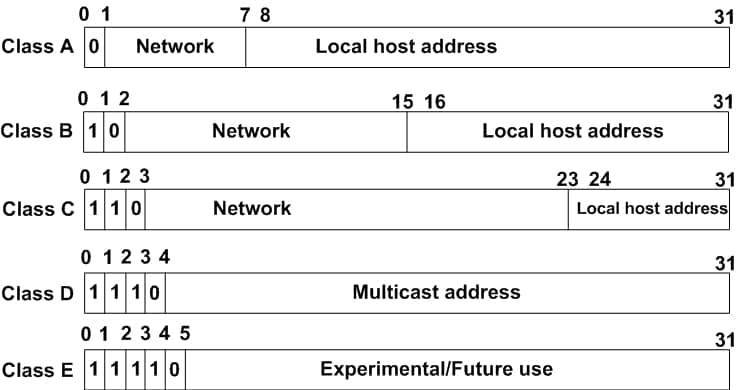1. 简介
IP 是 Internet Protocol(互联网协议) 的缩写。IP 地址是分配给连接到互联网网络中每台设备的唯一数字标识。 换句话说,它代表了你在互联网上的“住址”。本质上,它就像一个虚拟地址,让每台设备都能向正确的设备发送或接收数据。
在本文中,我们将探讨一个特殊的 IP 地址:0.0.0.0。但在开始之前,我们先快速回顾一下 IP 地址的一些基础知识。
2. 地址基础
IP 地址用于标识网络中的设备。例如,129.99.30.4 就是一个用点分十进制表示的 IP 地址。另一方面,子网掩码用于定义 IP 地址中哪一部分表示网络地址,哪一部分表示主机地址:

IP 地址分为五类:A、B、C、D 和 E 类。它们决定了每类地址可用的 IP 范围以及每个网络中可容纳的主机数量。下图展示了 A 到 E 类地址的基本结构:

- ✅ A 类地址:第一个比特为 0,接下来的 7 位用于网络标识,剩下的 24 位用于主机标识。最多支持 128 个网络,每个网络最多支持 16,777,214 台主机。
- ✅ B 类地址:前两个比特为 10,接下来的 14 位用于网络标识,剩下的 16 位用于主机标识。最多支持 16,384 个网络,每个网络最多支持 16,382 台主机。
- ✅ C 类地址:前三个比特为 110,接下来的 21 位用于网络标识,剩下的 8 位用于主机标识。最多支持 2,097,152 个网络,每个网络最多支持 254 台主机。
- ✅ D 类地址:前四个比特为 1110,其余 28 位用于多播地址。
- ✅ E 类地址:前四个比特为 1111,其余 28 位保留用于未来或实验用途。
3. 0.0.0.0 是什么?
0.0.0.0 是一个合法的 IP 地址格式(四个十进制八位组组成)。但它的主要用途不是作为实际分配给主机的地址,而是一个“占位符”或“默认”地址。
在不同场景下,0.0.0.0 有不同的用途。例如:
- ✅ 当服务器监听 0.0.0.0 时,意味着它将接受来自该机器上所有 IP 地址的连接请求。
- ✅ 它允许服务器监听所有可用的网络接口,包括 IPv4 和 IPv6。
- ✅ 在配置新网络接口时,管理员可能会暂时将 IP 地址设置为 0.0.0.0,直到分配到正确的地址为止。
3.1. 在计算机/服务器中的用途
0.0.0.0 常用于以下场景:
- ✅ 当设备尚未从 DHCP 服务器获取到有效 IP 地址时,它可以作为临时通信的源地址。
- ✅ 作为客户端尝试访问某个服务但该服务未绑定特定 IP 地址时的占位符。
- ✅ 服务器配置中,用作“通配符”地址,监听所有网络接口的请求。
⚠️ 踩坑提醒:如果你在服务器配置中看到监听地址是 0.0.0.0:8080,说明这个服务会监听所有网卡接口,可能会带来安全风险,需要配合防火墙策略使用。
3.2. 遇到 0.0.0.0 该如何处理?
如果你在设备上看到 IP 地址是 0.0.0.0,通常意味着:
- ❌ 该设备未正确配置 IP 地址。
- ❌ 未连接到网络或 DHCP 服务未正常工作。
如果你是管理员,建议检查网络配置,确认是否能正常获取 IP 地址。如果是客户端设备,可以尝试重启网络服务或联系网络管理员。
4. 总结
0.0.0.0 是一个特殊的 IP 地址,它不是一个可以分配给主机的有效地址,因为它并不指向任何一个具体的主机或网络接口。
它主要用于本地网络中作为占位符或默认路由地址,不会在互联网上被路由。例如:
- ✅ 作为服务器监听地址,表示监听所有网络接口。
- ✅ 作为默认网关地址,表示所有未明确指定目标的网络流量都应发送到该网关。
✅ 小贴士:0.0.0.0 与 127.0.0.1 不同。后者是本地回环地址,用于本机测试;而 0.0.0.0 是对外监听的“通配符”地址。